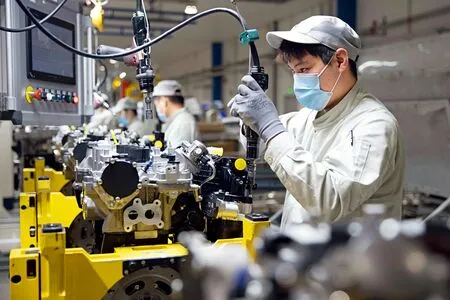CHINA’S 2022 ECONOMIC OUTLOOK
2022-06-23ByMarukawaTomoo
By Marukawa Tomoo
China is poised to achieve a milestone when it joins the ranks of high-income countries in 2022
C hina’s gross domestic product (GDP) exceeded 114 trillion yuan (US$18.1 trillion) in 2021, according to data released by the National Bureau of Statistics on January 17, an increase of 8.1 percent over the previous year—a rate slightly lower than I expected. Previously, I predicted that China’s economic growth could reach as high as 9 percent in fiscal year 2021 given that Chinese economic recovery began showing vigorous momentum in late 2020. China grappled with several tough challenges that hampered the country’s growth forecasts last year. Among them, Evergrande, China’s second largest property developer, fell into a debt crisis which negatively impacted China’s real estate industry as a whole. Another tough issue China faced was a significant power crunch from August to October, which forced many factories to cease operations.
When looking back at China’s overall economic growth in 2021, I was first impressed that the country produced a staggering 3.52 million new energy vehicles, equivalent to the total annual production of major car manufacturing countries including Brazil, Mexico, and South Korea.
Another thing that struck me was the Chinese government’s measures to tackle the debt problems of the Tsinghua Unigroup and the Evergrande. When China’s semiconductor conglomerate Tsinghua Unigroup was facing bankruptcy and Evergrande was on the verge of collapse last year, rather than opting for government intervention, which could have led to further problems, the Chinese government allowed the market to play a vital role and gave them the go-ahead to restructure. I think China adopted the right approaches on this difficult issue.
Economic Stability Top Priority
Some research institutes have predicted China’s economic growth rate to reach 5.1 percent in 2022, considering the current strength of the Chinese economy. I believe that either 5 percent or 4 percent would be fine. My reasons follow:
In 2021, China’s per capita GDP reached US$12,552, and the World Bank updated its definition of high-income economy as a nation with a gross national income (GNI) per capita of US$12,695 or more. So, China was already very close to the new metric of a high-income economy last year. I predicted China to become a high-income country around 2024. China almost hit the target last year and it is in the bag this year. Instead of continuing to strive for economic growth, China should focus more on economic stability.

Another unanticipated event is that China’s population increased by only 480,000 last year. Earlier, economists forecast China’s population to peak in 2030 before reaching a phase of negative growth. But according to 2021 data, China’s population is likely to start declining this year. If so, just a 4 percent growth rate could be enough to sustain economic development. Blindly pursuing a high growth rate will only lead to problems such as economic bubbles.
If the population remains as it is, China’s economic growth will be driven primarily by technological progress and capital accumulation.
While reading the communiqué of the Central Economic Work Conference released late last year, I paid particular attention to the part about “correctly understanding and grasping the characteristics and behavior rules of capital.” The communiqué reads:“The socialist market economy is a great creation, and there will inevitably be various forms of capital in the socialist market economy. We should give full play to the positive role of capital as a factor of production while effectively controlling its negative role. It is necessary to set up ‘traffic lights’ for capital, strengthen effective supervision of capital according to law, and prevent the barbaric growth of capital.”

Workers at an assembly line in an automobile engine plant in Harbin, Heilongjiang Province, on March 23, 2022. (ZHANG TAO)
This never-before-seen statement evidences China’s determination to exercise some oversight and control over capital, especially as capital is starting to show oligarchic tendencies. Already, some Chinese internet giants have evolved beyond their boundaries as ordinary businesses to serve as cornerstones of the country’s information infrastructure. Chinese people have become more and more dependent on lifestyle services provided by these companies, which indirectly leads to the emergence of oligarchic tendencies.
It is worth noting that previous spontaneous growth of private capital provided impetus for the development of the Chinese economy and accelerated the country’s technological advancement. So it is important to ensure that such capital continues to maintain growth momentum. Furthermore, most private companies in China are struggling with intense competitive pressure due to some internet giants’ monopolistic operations that need to be broken up. Implementation of capital market supervision policy should be specific and leverage the pros while avoiding the cons.
The government should also play a significant role in fostering new drivers of economic growth. For example, development of autonomous vehicles and new energy vehicles cannot simply rely on private capital. The government should facilitate construction of roads, traffic lights, and other infrastructure, maintain thorough communication with non-governmental agencies, create conditions for practical application of relevant technologies, and establish relevant rules. Clearly, the rapid development of new energy vehicles in China is largely thanks to local governmental incentives such as license plate privileges seeking to boost sales of new energy vehicles.
If the population remains as it is, China’s economic growth will be driven primarily by technological progress and capital accumulation.
The communiqué of the Central Economic Work Conference reiterated the need to “adhere to the supply side structural reform as the main line,” but said China would not adopt a zero interest rate policy or quantitative easing like Japan did. The communiqué called for efforts to “carry out infrastructure investment moderately ahead of time.” If this year’s economy fails to rebound as hoped, China could roll out investment incentives to boost economic growth.
CPTPP & SOE Reform
This year, Japan and China will implement major projects on economic and trade cooperation.
The Regional Comprehensive Economic Partnership (RCEP) trade agreement covering 15 countries including Japan, China, and South Korea took effect in January. RCEP is the first free trade agreement involving China, Japan, and South Korea, and its signing will certainly make a positive impact on the Japanese economy. Japanese companies will start seeing more opportunities which should be seized in a bold and efficient manner.
Some have argued that the RCEP is not liberal enough. Well, Japan—not the RCEP—is the party to blame for that. Generally, members of RCEP are expected to phase out tariffs on 91 percent of goods, but Japan still maintains high tariffs on agricultural and livestock products such as rice, wheat, beef, and pork. Japan’s tariff elimination rate is 88 percent for ASEAN, 86 percent for China, and 81 percent for South Korea.

The multilateral trade pact needs to be improved regardless of which country will dominate in the future; its entry into force is not an end. All member states including Japan, China, and South Korea should further enrich the content of cooperation so that the RCEP framework can extend beyond free trade to influence a wider range of areas.The Comprehensive and Progressive Agreement for Trans-Pacific Partnership (CPTPP) is another issue that will influence Japan-China relations this year. China officially submitted its application to join the CPTPP last September, and Japan, one of the founding members, has been taking a cautious waitand-see approach.
Some analysts have called China’s application to join the CPTPP competition for the U.S. presence in the region. But there is no logical reason for international trade to target or exclude any particular country. In this sense, I support China’s accession to the CPTPP and also call for Japan and other CPTPP members to support China.
China still has obstacles to overcome to join the CPTPP. Government subsidies to stateowned enterprises (SOEs) as well as cross-border data flows are two major challenges.
China has as many as 200,000 SOEs, so obviously CPTPP could not exclude all of them. The key is preventing relevant policies from adversely affecting normal trade. For example, SOEs can engage in trade, but they cannot expand exports by leveraging government subsidies. So, it would not be an insurmountable problem if all parties could thoroughly communicate and make clear rules.
The CPTPP agreement states that parties shall ensure unrestricted flow of information and data related to the internet and the digital economy, and that no party should prevent internet service providers or consumers from transferring, accessing, processing, or storing relevant information across borders. This contradicts provisions of current Chinese law. However, objections to the free flow of data across borders have been growing in Europe and Japan alike. Instead of requiring China to comply with the CPTPP, member states will more likely find mutually acceptable solutions through negotiations, such as a new provision prohibiting crossborder transfer of important personal data without the owner’s consent.
On the issue of China’s application for CPTPP membership, it is important that member countries communicate and negotiate with China on such topics. When China applied to join the World Trade Organization (WTO) 20 years ago, it also navigated many rounds of negotiations involving extraordinarily tough requirements, but finally succeeded after overcoming various difficulties. Today, China’s efforts to join the CPTPP will likely bolster the country’s SOE reform.
